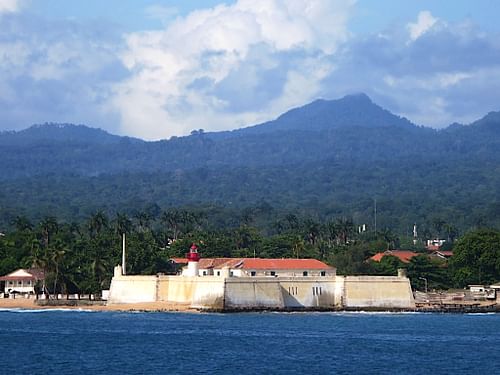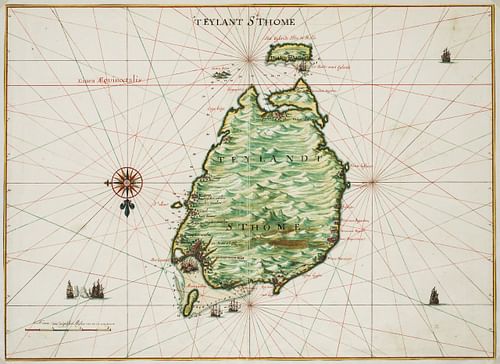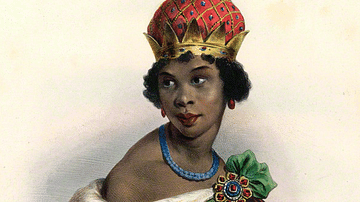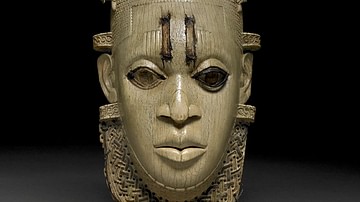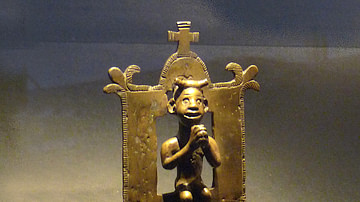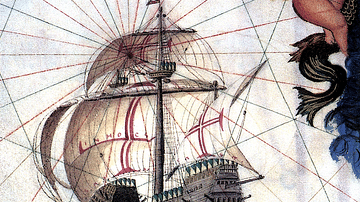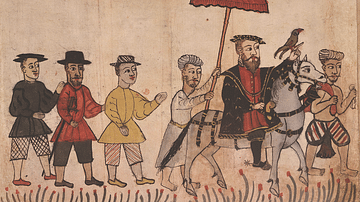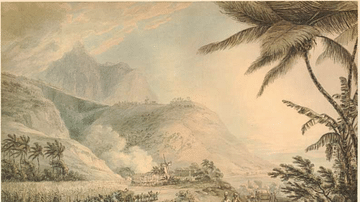São Tomé and Principe are islands located in the Gulf of Guinea in West Africa. They were uninhabited before being colonised by the Portuguese from 1486. So involved were they with the slave trade, they became known as the Slave Islands where West Africans were gathered in their thousands and shipped to work plantations in such colonies as Portuguese Brazil.
Sugar cane was grown on the islands and the plantations required slaves from the mainland which were acquired through trade with such states as the Kingdom of Benin and the Kingdom of Kongo. When plantations in the Americas created a huge new demand for slaves, São Tomé and Principe acted as a collecting station for shipment of humans across the Atlantic. Tropical diseases eventually reduced the European population to only a handful and so most of the free population were of mixed European and African heritage. The islands gained independence from Portugal in 1975 and became the Democratic Republic of São Tomé and Principe.
Geography & Climate
The two islands of São Tomé and Principe, along with a few associated rocky islets, are located in the Gulf of Guinea on the southern coast of West Africa. The main islands are a mix of flat and mountainous areas of seemingly dormant volcanoes. São Tomé Peak is the highest point in the group, reaching a height of 2,024 metres (6,640 ft). The steepness with which these mountains descend to the sea means there are no deepwater harbours. The total land area of the islands is 964 square kilometres (372 sq. mi).
Situated right on the equator, the climate is tropical with a long wet season, and the islands were once entirely covered in rainforest. On the plus side, the rich volcanic soil, long growing season, and plentiful rain made the islands suitable for growing many important foodstuffs like sugar cane during colonization. On the downside, tropical diseases, particularly malaria, ran riot on the islands when populated and remain a problem today.
Settlement
The Portuguese Crown had already colonized with success three archipelagoes: Madeira (1420), the Azores (1439), and Cape Verde (1462) in the Atlantic off the coast of West Africa. These islands were very useful strategic points for Portuguese ships that criss-crossed the empire, and they had also been cultivated with success to produce goods for trade. To work on plantations of wheat, sugar cane, and cotton, slaves had been imported from West Africa. By 1470, the Portuguese were keen for a base even closer to the lucrative trade markets in the southern part of West Africa. The two uninhabited islands of São Tomé and Principe were discovered by Portuguese mariners and found to be ideal candidates for such a base. Settlement occurred first on São Tomé but did not begin until 1486.
As with the Portuguese colonization of the Azores, Madeira, and Cape Verde, the Crown partitioned the islands and gave out ‘captaincies’ (donatarias) as part of the system of feudalism to encourage nobles to fund their development. Each ‘captain’ or donatario was given the responsibility of settling and developing their area in return for financial and judicial privileges, Accordingly, ’captains’, in turn, distributed parts of their estates to their followers for development, parcels of land known as semarias. Men given such land had the responsibility of clearing it and beginning cultivation within a set period. The captaincies became hereditary offices in many cases. The model of donatarias would be applied to other Portuguese colonial territories in the future, notably in Brazil.
Just as with the Portuguese colonization of Madeira and the other Atlantic islands, settlers came from a variety of backgrounds. There were Portuguese from both Portugal and the Atlantic colonies (especially Cape Verde), Jews seeking religious freedom, the children of Jews who were forced to separate from their families in Portugal, undesirables from Portugal such as deportees, and a number of other Europeans keen to start a new life. Free Africans also came to the islands and intermarriages resulted in a significant population of mixed-race peoples. The white inhabitants never exceeded 1,000, and by 1600, there were fewer than 200.
One of the main reasons for the decline in the European population was the tropical diseases which blighted the islands. Indeed, such was their reputation, many a prospective governor refused the appointment from the Portuguese Crown or took the appointment but never actually showed up on the islands. As one anonymous description, dating to the first half of the 16th century, notes:
Throughout the year the white inhabitants of the town [on São Tomé] usually suffer a sort of intermittent fever every eight or ten days as follows: First comes cold and then heat, and it all passes off in two hours according to each person’s constitution. This complaint happens to those who live permanently there, and they are accustomed to bleed themselves three or four times a year. However, for foreigners who come there on board the ships, the first fever which attacks them usually lasts twenty days and is often fatal.
(Newitt, 60-61)
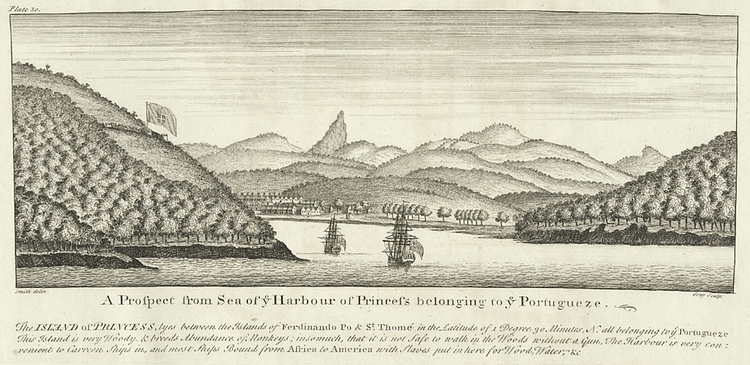
In 1486 the Portuguese Crown gave the islanders a license to trade on the mainland. Accordingly, merchants and adventurers from the islands set up trading posts all along the coast as far south as Luanda (in modern Angola). At first, traders were interested in acquiring such goods as gold, pepper, and ivory, but these later became secondary to human traffic. This trade accounted for the island’s peak in prosperity from around 1530 to 1560. In 1534, the bishopric of São Tomé was established, and it had, rather ambitiously, jurisdiction over the whole of the coast of Africa all the way down to the Cape of Good Hope.
Slavery
As on the Portuguese Atlantic islands, sugar cane was planted with success in the 16th century where the humid climate aided a fast growth. On the other hand, the humidity meant that thoroughly drying the cane was difficult and so the sugar produced on the islands was never of the highest quality. A labour-intensive industry, plantations (roças or fazendas) needed plenty of planters and harvesters and a watermill or engenbo to process the cane. São Tomé had only two such mills in 1517 but 60 by 1550. One anonymous visitor, writing in 1550, noted that the islands were then producing around 150,000 arrobas of sugar a year, that is around 2.25 million kilograms (5 million lbs). Unfortunately, just as the industry was taking off, the rise of the larger and more modern plantations in Brazil in the 1550s saw this crop decline on São Tomé and Principe from the 1580s.
Slaves, both men and women, were shipped from the mainland to work on the sugar plantations, notably from the Kingdom of Benin and the Kingdom of Kongo in the 16th century. Slaves lived in rudimentary villages on the plantations and were permitted at weekends to grow food for their own sustenance on small plots of land.
The Portuguese traded cotton clothing, silk, glazed china, glass mirrors, knives, and glass beads for slaves. As the demand grew for slaves, traders from São Tomé and Principe tried to cut out the Kongo kings, who were essentially the middlemen between them and traders in Africa’s interior. The Europeans and mixed-Europeans began to send their own slave-hunting parties into the interior and even grabbed the Kongolese themselves. On the other side, the Kongo kings resented European cultural and religious interference in their affairs, and they were not slow to appreciate the rewards if they themselves shipped slaves to Europe and cut out the Portuguese. As a result of the decline in relations from the mid-16th century, the Europeans moved further south to the region of Ndongo to find their slaves.

With the decline of the sugar industry, the islands at least profited from the success of the crop in the Americas where slaves were now needed to work the plantations there. The islands thus became a hub in the trade network that shipped African slaves to Europe, North Africa, and across the Atlantic to the Americas, particularly the Spanish Caribbean and Brazil. The islands acted as a gathering point for slaves and as a place to take onboard provisions for the ships which would carry the human cargo.
Slave Rebellions
Compared to the other Portuguese colonial islands in the Atlantic, São Tomé and Principe had much larger slave populations, and this eventually caused some serious problems. Put simply, the European settlers failed to control the slaves. The causes were the deterioration of the living conditions on plantations as the sugar cane industry went into decline and the lack of any military authority except a local and ineffective militia force. There were major rebellions in 1574 and 1586. Many slaves escaped to the mountainous interiors, where there were already bands of renegade Africans from Angola, and from there they regularly raided the plantations. In 1595-6, one slave leader called Amador, who declared himself the ‘King of the Slaves’, almost succeeded in taking over the entire island of São Tomé. The slave rebellions were another reason for the few remaining Europeans and also the mixed-race settlers to abandon the islands and try for a new life in the booming sugar cane plantations of Portuguese Brazil.
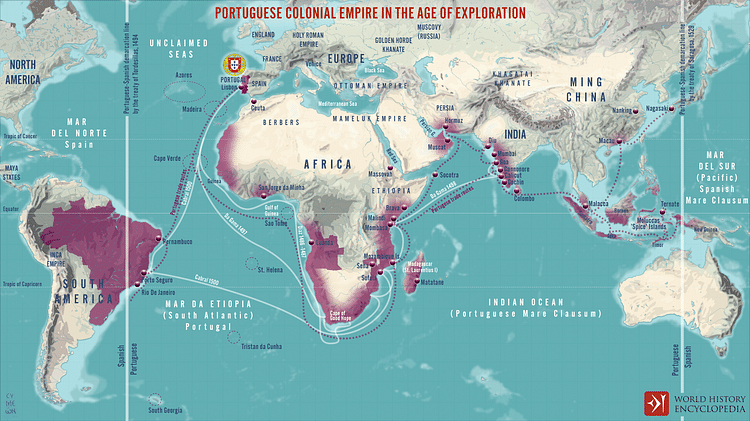
Later History
Competition for trade between the European powers heated up in the 17th century. Pirates were another constant threat to the islands and the ships which called at them. Dutch ships attacked both islands in 1598-9 and even took over São Tomé for seven years from 1641 to 1648. Back in Portuguese hands after the Crown had sent an expedition force, in 1711 the French attacked the islands. Santo António on Príncipe, with its much better harbour, became the capital in 1753, replacing São Tomé on its namesake island. This was a reflection of the reversal of fortunes for the two main islands after Principe had always been in the other’s shadow. In 1777-8, the Portuguese gave the small islands of Annobón (Pagalu) and Bioko (formerly known as Fernando Pó) to appease the Spanish who were eager to muscle in on the slave trade themselves. The Portuguese had never attempted to settle these rocky islands, and Bioko had its own African residents even before the Portuguese had arrived back in 1470.
From the early 19th century, cacao and coffee were grown with some success on the islands, with the former crop still dominating today. Slaves continued to be imported from the mainland to work these plantations, a trade not prohibited until 1908. Even in the 20th century, when African labourers (largely from Angola and Mozambique) had to be repatriated after a certain number of years, the living conditions were little different from those their slave predecessors had had to bear.
São Tomé and Principe gained independence from Portugal in 1975, but mismanagement of the country’s plantations saw low production continue just as it had before during the long period of colonial neglect. Roman Catholicism continues to be the most practised religion, and Portuguese remains the official language. Trade with Portugal and the Netherlands continues to dominate the country’s economy.
